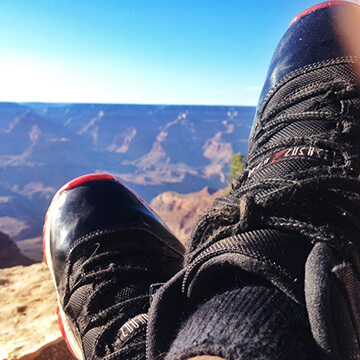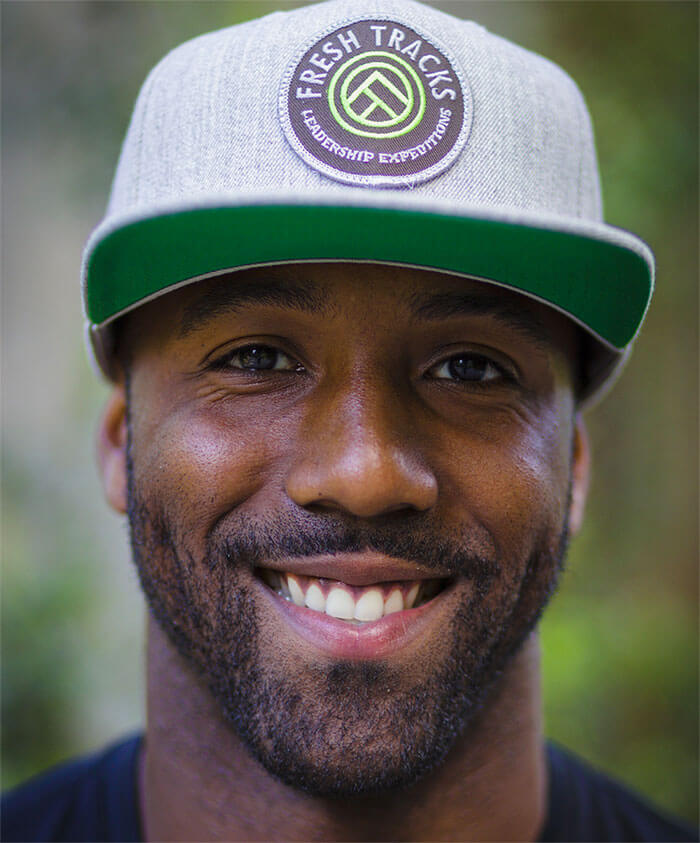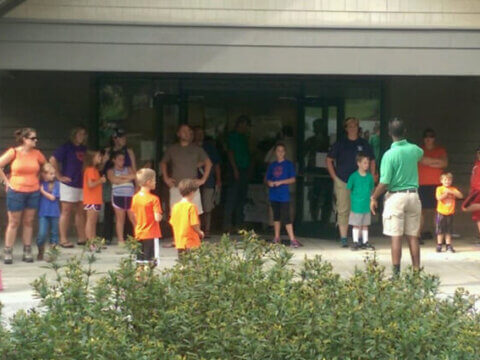Why I Wear Jordans in the Great Outdoors: A Natural Leader Builds Bridges Between Worlds
 I am an African American Natural Leader. That phrase is not an oxymoron, but it’s also not something that you normally see in the environmental world.
I am an African American Natural Leader. That phrase is not an oxymoron, but it’s also not something that you normally see in the environmental world.
In the few years that I have been involved in environmental education and connecting people with outdoor spaces, there have been numerous occasions where I am the only person of color in the program, or the only African American leader. Growing up, there was no one from my neighborhood traveling, hiking, canoeing, or spending time outdoors unless it was a part of a regimented program.
I write, neither to complain that the outdoor world is an elitist one, nor to lament the disconnect between the world I grew up in and the natural world where I now lay roots. I write to celebrate the amazing opportunity available for me (and others like myself) to be a bridge between the two worlds.
On my feet as I write are Jordan Bred 11’s, the only pair of Michael Jordan’s sneakers I have ever owned in my life. Jordan sneakers are a status symbol in the neighborhood I grew up in, a memento of importance and significance. Unfortunately, for some people, they hold higher value than food, books, rent, and in some extreme cases, even the life and well-being of another individual.
So it makes sense that while facilitating an outdoor youth summit this June at Harpers Ferry National Park (Virginia), an African-American teenage boy stopped me to ask why I was wearing these Bred 11s outdoors. I laughed, because that same question and all the underlying ones that accompanied it had been asked of me multiple times that week, and my introspective journey in figuring out that answer led me to write this post.
In response, I asked him if he had ever seen someone from the “outdoor world” wearing Jordans. His answer was no. I asked him if he had seen anyone who would wear Jordans exploring the outdoors like we were, and again he said no.
 The disconnect between the two circles was evident, and as we looked around, we could see that even there, we were in the minority.
The disconnect between the two circles was evident, and as we looked around, we could see that even there, we were in the minority.
And with that same mindset, I used to believe that I stood on a decrepit bridge between two worlds…
I have heard the rallying cry echo through the trees, affirming that the outdoors are for people of all creeds, countries and colors. I have been a part of programs that aim to introduce these natural spaces to kids from the inner city who don’t have the awareness, opportunity or means to go camping or hiking every weekend.
I have heard the questions posed every time I prepare to travel to a wild place away from home, and seen the confusion that arises when my family attempts to describe what I do.
But two summers ago, in the infancy of my outdoor career, while serving as a trip leader for the North Cascades Institute, the seed of connection between two seemingly mutually exclusive circles was planted. I was the only male African American leader, and quickly learned the importance of setting an example. During that time, I had many conversations with the teenagers on my trips about where I came from, what I was doing living out in nature, and why I chose to do it.
That summer, as I learned the nuances of nature and the outdoors right alongside my kids, nature taught us both struggles and pain, knots and the power of perseverance. And although I took notice of the difference between where I was at that moment and where I grew up, without any intentional nurturing from me, the seed of connection between the two worlds took root and grew.
Eventually it came to my conscious attention through one of the teenagers on my trip, who on our last day, as we were preparing to separate, said “he enjoyed being outdoors in the nature because CJ did.” And I realized the tremendous impact that I could have.

I no longer saw the singularity of my skin tone among my peers as a problem, but instead as a megaphone to give weight to the message that as people of color, people from different ethnic backgrounds, the outdoor world is ours to explore as well. And for those who have grown up connected to and educated in the outdoors, they now have the chance to connect to new cultures, to see flora and fauna through the eyes of city kids.
Along this journey, I have met several other natural leaders of different ethnicities doing similar and amazing work, both in the inner city and out in parks and natural spaces around the country. I had the opportunity to attend the 2013 Natural Leaders Legacy Camp, where I connected with fifty other leaders with similar mindsets, strengthening my resolve, knowing I am not the only one out there.
My Jordans are falling apart, worn from adventures in places like the Grand Tetons and the Grand Canyon. This goes directly against how people “should” wear them and what people “should” wear outdoors. But I wear them wherever I go to remind me of the fact that though there are two worlds, I am a bridge.
In our current society, where youth as a whole do not spend significant time outdoors, I am encouraged by that realization as I have continued to work in outdoor and conservation related fields, and I am constantly reassured of its validity when I see yet another kid from the inner city follow the footprints of my Bred 11s into the woods.
5 Comments
Submit a Comment
-
Network News
Earth Day: Young leaders advocate for change
-
Feature
Nature photographer Dudley Edmondson has a vision for the representation of Black and Brown faces in the outdoors
-
Richard Louv
EARTH MONTH: You're part of the New Nature Movement if....
-
Voices
Placemaking: How to build kinship and inclusive park spaces for children with disabilities
-
Network News
Children & Nature Network founders release report on global factors influencing the children and nature movement






I came here because I listened to your interview on NPR.
Congratulations on your mentoring of young people. It is important to foster many interests. My mentoring was from my family. We went to parks and hiked for family outings. We did this because it was free. The same reasoning for the family garden. We raised our own food to save money. We did not have the hiking boots, the hats, the shorts or the hiking staffs. We wore tennis shoes, flats, flip flops, work boots, or what ever shoe that member of the family had to wear. We never thought to buy any special shoe to go on a hike, and we usually ended up cleaning our shoes when we got home so we could wear them in public. Those privileged people you referred to in your interview are those with money who can afford extra shoes. There’s no race in the lack of money.
Reply from CJ Goulding:
Hi Mark,
It sounds like the idea that you can go outside wearing whatever you have on resonates with your story of connecting to the outdoors. I am glad that you had your family to serve as mentors in that aspect. You are correct, growing up without money is not something unique to any particular culture/race. Kimberlé Crenshaw and her theory of intersectionality lets us know that different identities and factors compound in creating barriers to access and equity. Race is one of those factors in how we live our daily lives and in connection to the outdoors.
This story is an affirmation of all parts of my identity while stepping into the outdoors, including my race, my culture, and socioeconomic background. Leaving any of those parts of the story out means leaving a part of me behind. As you continue to connect to the outdoors, it is my hope that you and everyone else reading this is able to connect while bringing their full selves into the outdoors, not leaving anything behind, and working to address and remove whatever barriers exist, even if they do not exist for us individually.
Re: There’s no race in the lack of money
I also want to acknowledge that in the case of the United States, we have large income gaps among different racial groups where the average household income of a white family is 10-15 times of a black family. While I hear that the experience of poverty isn’t based on skin color, the oppressive white supremacy culture that we live in also creates such environment. Intersectionality is an important and useful concept, although the influence of race in our nation is also a formidable one that shall not be trivialized.
I enjoyed reading this. One sentence stuck out, “My Jordans are falling apart.” I would personally like to rectify that by buying Mr Goulding a new pair of Jordans. Could you please tell me how that might be accomplished?
Sincerely,
Gilles Carter, 526 Thompson Ave, East Haven, CT 06511 (917) 612-4334
Hi, Gilles. This was really thoughtful of you. We passed your comment along to CJ and he sends his thanks and this response:
From CJ Goulding:
Thank you for this thought! I am appreciative and grateful for the gesture. Part of the message of this piece is that we can put energy towards breaking down the barriers that exist for young people to access the outdoors and show up as their full selves. Let’s donate/use those funds to support young people and organizations in New Haven working with youth and young adults, connecting them to nature, and addressing the inequities in their lives.
One place I might suggest to support is the Outdoor Adventure program with New Haven Parks & Recreation. Contact information: New Haven Parks & Rec Outdoor Adventure Coordinator, Martin Torresquintero, MTorresq@newhavenct.gov
Another suggestion would be the City of New Haven Youth Violence Prevention Initiative. Link
Again, grateful for the thought, let’s use these funds to support similar experiences for other young people.